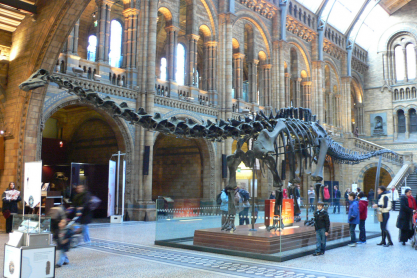The museum was not always the thriving and successful organisation that we now know of, as after a number of years most of Sloane's specimens were destroyed because the museum and it's staff failed to preserve them properly. A decision was therefore made to move the museum, so a huge piece of land was bought in Kensington where work began to create the beautiful building that stands there today.
The new museum opened in 1881 and was legally a department of the British Museum. However, after much petition by the public and iconic scientists such as Charles Darwin and Aldous Huxley, the museum gained independence and became an institution in its own right.
Over the years the museums collections have grown to be vast and plentiful, and they include five main ones: zoology, botany, mineralogy, etymology, and palaeontology. It has become world renowned as being a centre of research excellence, and it houses many books, journals and specimens of incredible historic and scientific value, including collections from Charles Darwin.
There are many iconic images associated with the museum, such as "Dippy", the replica Diplodocus skeleton that expands 105 feet across the main hall to greet visitors as they enter through the main doors. In the Large Mammals Hall there is a skeleton and model of a blue whale that dwarfs all of the other models around it. Earlier this year it was actually decided that "Dippy" has had his day, and he is to be replaced by a blue whale skeleton in a couple of years that will take pride of place in the main hall. At the other entrance of the museum there is a large model of the Earth that people are taken through on the escalators. It was built with the intention of enticing people to visit the upper galleries as these were a less popular attraction, and it has worked with much success.
The museum also includes the Darwin Centre which was opened in 2002 and contains many of the millions of specimens contained within the museum, including all kinds of plants and animals. There is also the Attenborough Studio, which opened only a couple of years ago with the purpose of celebrating the great public engagement and science communication that the museum is responsible for. It is a multimedia centre with a number of science demonstrations, lectures and interactive elements that the public can enjoy. This area is particularly great for school trips.
The Natural History Museum has found itself at the centre of quite a lot of media attention. A six-part BBC documentary called the 'Museum of Life' was released in 2010 that explored its history and gave an interesting, in-depth behind the scenes account of the museum. It has also featured in many works of literature and was a focal point of the 2014 film, Paddington.
The museum has 850 staff, is publicly funded and free to enter, and in the past decade has seen the number of visitors increase threefold. With the public's interest in science growing and the museum developing as it is, the success will only continue for this iconic and world-class institution.




